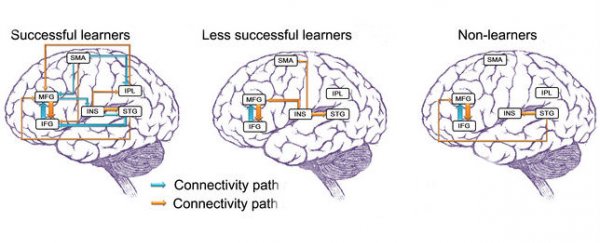Researchers from Penn State University in the US have found that learning a language will change the structure of your brain and make the network that pulls it all together more efficient - and the improvements can be experienced at any age.
Every time you learn something new, you're strengthening your brain. Just like physical exercise strengthens your various muscles, tissues and organs, the more you exercise specific areas in the brain, the stronger and more connected those areas will become.
The Penn State team decided to observe the brain activity of native English-speakers as they went through the process of learning Chinese - specifically, Mandarin - vocabulary. They gathered 39 volunteers of varying ages and scanned their brains over a six-week period as half of them took part in language lessons and the other half acted as control subjects. The participants were put through two functional magnetic resonance imaging (fMRI) scans, one before the experiment began and then another one after six weeks, and the team observed the physical changes that had occurred.
The team found that, compared to the group that didn't participate in the language lessons, the group that did had undergone several structural and functional changes in their brains. First off, their brain networks had become better integrated, which means they're more flexible and allows for faster and more efficient learning. They also found that those who excelled in the language lessons had more integrated networks than the brains of those who struggled, even before the experiment had begun, suggesting that they habitually sought out new things to learn and exercise their brains with.
The way the researchers determined the level of connectivity and efficiency of their participants' brain networks was by analysing the strength and direction of the connections between specific regions of the brain that become active in learning. The stronger these connections - or edges - are between one area to the next, the faster and more efficiently they can work together as a whole network.
The team also found that the language-learning participants ended up with increased density in their grey matter and that their white matter tissue had been strengthened. Grey matter is a type of neural tissue that encompasses various regions in the brain associated with muscle control, memory formation, emotions, and sensory perception such as seeing and hearing, and it's white matter's job to connect these grey matter regions together in the brain's cerebrum, sort of like a train line for your brain.
"The evidence reviewed so far portrays a picture that is highly consistent with structural neuroplasticity observed for other domains," the team concludes in the Journal of Neurolinguistics. "Second language experience-induced brain changes, including increased grey matter (GM) density and white matter (WM) integrity, can be found in children, young adults, and the elderly; can occur rapidly with short-term language learning or training; and are sensitive to age, age of acquisition, proficiency or performance level, language-specific characteristics, and individual differences."
The researchers are now working on figuring out how to teach language in new, very different ways to maximise these functional and structural changes in the brain, including the use of 3D virtual environments.
"A very interesting finding is that, contrary to previous studies, the brain is much more plastic than we thought," said lead researcher and professor of psychology, linguistics and information sciences and technology, Ping Li, in a press release. "We can still see anatomical changes in the brain [in the elderly], which is very encouraging news for ageing."
Source: Penn State University
